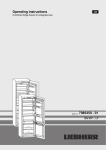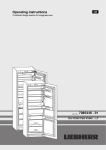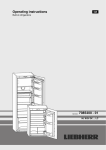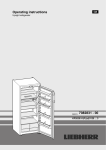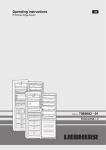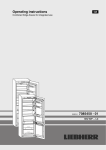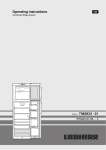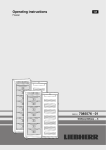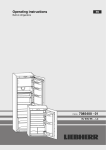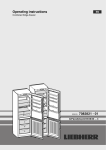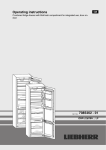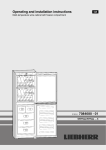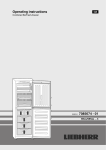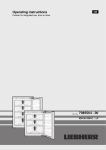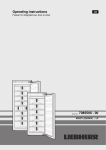Download Liebherr SICN 3356 fridge-freezer
Transcript
Operating instructions Combined fridge-freezer for integrated use, door-on-door 140114 7085454 - 01 ICN/ SICN/ ICNP ... LP Appliance at a glance Contents 1 Appliance at a glance 1 1.1 1.2 1.3 1.4 Appliance at a glance............................................ Description of appliance and equipment.................. Range of appliance use............................................ Conformity................................................................ Saving energy.......................................................... 2 2 2 3 3 2 General safety information................................... 3 3 3.1 3.2 Controls and displays........................................... Operating and control elements............................... Temperature display................................................. 4 4 4 4 4.1 Putting into operation............................................ Switching on the appliance....................................... 5 5 5 5.1 5.2 5.3 5.4 5.5 Control.................................................................... Child proofing........................................................... Door alarm................................................................ Temperature alarm................................................... Refrigerator compartment........................................ Freezer compartment............................................... 5 5 5 5 5 7 6 6.1 6.2 6.3 6.4 Maintenance........................................................... Defrosting with NoFrost............................................ Cleaning the appliance............................................. Cleaning the IceMaker............................................. Customer service..................................................... 10 10 10 10 11 7 Malfunction............................................................. 11 8 8.1 8.2 Decommissioning.................................................. 12 Switching off the appliance....................................... 12 Taking the appliance out of service.......................... 12 9 Disposing of the appliance................................... 13 The manufacturer works constantly on the further development of all the types and models. Therefore please understand that we have to reserve the right to make design, equipment and technical modifications. To get to know all the benefits of your new appliance, please read the information contained in these instructions carefully. The instructions apply to several models. Differences may occur. Text relating only to specific appliances is marked with an asterisk (*). Instructions for action are marked with a action are marked with a . , the results of 1.1 Description of appliance and equipment Fig. 1 (1) Operating and control elements (2) Fan (3) LED light column (4) Shelf (5) Shelf, sectioned (6) Water tank* (7) Drain hole (8) Coldest zone (9) Vegetable bin (10) Boxes (11) Can rack (12) Bottle rack (13) Bottle holder (14) LED lighting, freezer compartment (15) IceMaker* (16) Cold storage accumulators (17) Information system (18) Freezer compartment drawer (19) Soft stop mechanism (20) Type plate Note u Place food inside the appliance as shown in the diagram. This allows the appliance to save energy during operation. u Shelves, drawers and baskets are arranged for optimum energy efficiency on delivery. 1.2 Range of appliance use The appliance is suitable solely for cooling food in a domestic environment or similar. This includes use in, for example - in staff kitchenettes, bed and breakfast establishments, - by guests in country homes, hotels, motels and other forms of accommodation, - in catering and similar services in the wholesale trade 2 * Depending on model and options General safety information Use the appliance solely as is customary within Information for testing institutes: In order to determine the standard energy consumption a domestic environment. All other types of use and the storage time during malfunction, the cold are inadmissible. The appliance is not suitable storage accumulators must be arranged in accordance with for storing and cooling medicines, blood the manufacturer's loading plan. plasma, laboratory preparations or similar substances and products covered by the 2 General safety information 2007/47/EC Medical Devices Directive. Misuse of the appliance can result in the stored prod- Danger for the user: ucts suffering harm or perishing. Furthermore, - This appliance can be used by children of 8 the appliance is not suitable for operation in years old and over, and also by persons with potentially explosive atmospheres. restricted physical, sensory or mental capacity or lack of experience and knowlThe appliance is set to operate within specific edge, if they are supervised or have been ambient temperature limits according to its instructed on safe use of the appliance and climate rating. The correct climate rating for understand the resulting risks. Children must your appliance is indicated on the type plate. not be allowed to play with the appliance. Note Cleaning and user maintenance must not be uCompliance with the ambient temperatures carried out by children without supervision. indicated is required, otherwise the cooling - When disconnecting the appliance from the performance is reduced. supply, always take hold of the plug. Do not pull the cable. Climate for ambient temperatures of - In the event of a fault pull out the mains plug rating or deactivate the fuse. SN 10 °C to 32 °C - Do not damage the mains power cable. Do N 16 °C to 32 °C not operate the appliance with a defective ST 16 °C to 38 °C mains power cable. Have any repairs to or intervention in the T 16 °C to 43 °C appliance, and any change of the mains power cable, carried out by the customer 1.3 Conformity service only or by other specialised personnel The refrigerant circuit is tested for leakage. When built-in the trained for the purpose. appliance complies with the relevant safety regulations and EC Only install, connect and dispose of the appliDirectives 2006/95/EC, 2004/108/EC, 2009/125/EC and 2010/30/EU. ance according to the instructions. - Only use the appliance when it is installed. Note for test institutions: Tests are to be carried out according to the applicable - Please keep these instructions in a safe place standards and guidelines. and pass them on to any subsequent owners. Preparation and testing of the appliances must be carried - All repairs to and intervention in the IceMaker out taking the manufacturer's loading plans and the may be carried out only by service personnel notes in the operating manual into account. or by other skilled personnel trained for the purpose.* 1.4 Saving energy - Special-purpose lamps (incandescent lamps, - Always ensure good ventilation. Do not cover ventilation LEDs, fluorescent tubes) in the appliance openings or grille. serve to illuminate the appliance interior and - Always keep fan louvres clear. are not suited for room illumination. - Do not place appliance in areas of direct sunlight or next to a stove, heater or similar object. Fire hazard: - The energy consumption depends on the installation conditions, e.g. the ambient temperature (see 1.2) . - The refrigerant R 600a is environmentally - Keep the time the appliance is open to a minimum. friendly but flammable. Escaping refrigerant - The lower the temperature setting, the higher the power may ignite. consumption. • Do not damage the refrigerant circuit pipes. - Store food logically. (see Appliance at a glance). - Ensure that all food is well packed and covered for storage. • Do not allow naked flames or ignition This will prevent frost from forming. sources to enter the appliance. - Remove food as needed in order that it does not warm too • Do not use any electrical appliances in the much. - First cool warm food to room temperature before storing it . interior (e.g. steam cleaners, heaters, ice - Defrost frozen food in the refrigerator. cream maker etc.). - Empty and switch off refrigerating unit for longer vacation • If refrigerant escapes: remove any naked periods. flames or sources of ignition from the * Depending on model and options 3 Controls and displays leakage area. Ventilate the room well. 3 Controls and displays Notify the after-sales service. - Do not store explosives or sprays using 3.1 Operating and control elements combustible propellants such as butane, propane, pentane, etc. in the appliance. To identify these spray cans, look for the list of contents printed on the can, or a flame symbol. Gases possibly escaping may ignite due to electrical components. - Please be sure to store alcoholic drinks or other packaging containing alcohol in tightly closed containers. Any alcohol that leaks out may be ignited by electrical components. Danger of tipping and falling: - Do not misuse the plinth, drawers, doors etc. as a step or for support. This applies particularly to children. Danger of food poisoning: - Do not consume food which has been stored too long. Danger of frostbite, numbness and pain: - Avoid lasting skin contact with cold surfaces or refrigerated/frozen food or take protective steps, e.g. wear gloves. Do not consume ice cream, water ice or ice cubes immediately and do not consume them too cold. Fig. 2 Danger of injury and damage: (1) Refrigerator compart(12) Freezer compartment ment On/Off button Down setting button - Hot steam can lead to injury. Do not use eleccompart(13) SuperFrost button trical heating or steam cleaning equipment, (2) Refrigerator ment temperature open flames or defrosting sprays to defrost. display - Do not use sharp implements to remove the (3) Refrigerator compart(14) SuperFrost symbol ment Up setting button ice. (4) Refrigerator compart(15) Alarm button Risk of crushing ment Down setting button - Do not reach into the soft stop mechanism. (5) Ventilation button* (16) Alarm symbol Fingers may be trapped when the door is (6) Ventilation symbol* (17) Menu symbol (7) SuperCool button (18) Child lock symbol closed. (8) SuperCool symbol (19) IceMaker symbol* Please observe the specific information in (9) Refrigerator compart(20) Water tank symbol* ment On/Off button the other sections: 4 DANGER identifies a situation involving direct danger which, if not obviated, may result in death or severe bodily injury. WARNING identifies a dangerous situation which, if not obviated, may result in death or severe bodily injury. CAUTION identifies a dangerous situation which, if not obviated, may result in minor or medium bodily injury. NOTICE identifies a dangerous situation which, if not obviated, may result in damage to property. Note identifies useful information and tips. (10) Freezer compartment temperature display (11) Freezer compartment Up setting button (21) Power failure symbol 3.2 Temperature display The following are displayed in normal operation: - the warmest freezing temperature - the average cooling temperature The freezer compartment temperature display flashes: - the temperature setting is being changed - after switch-on the temperature is not yet cold enough - the temperature has risen several degrees Dashes flash in the display: - the freezer temperature is above 0 °C. * Depending on model and options Putting into operation The following displays indicate malfunction. Possible causes and corrective action (see Malfunction). - F0 to F9 - FE* - The power failure symbol shines. 4 Putting into operation 4.1 Switching on the appliance Note u To switch on the entire appliance it is necessary only to switch on the freezer compartment. Switch on the appliance approx. 2 hours before adding frozen food for the first time. Do not load food to be frozen before the temperature display reads -18 °C. 4.1.1 Switching on the freezer compartment u Open the door. u Press On/Off button, freezer compartment Fig. 2 (9). w The temperature display of the refrigerator compartment indicates the current temperature inside. w The temperature display of the freezer compartment and the alarm symbol flash until the temperature is sufficiently low. If the temperature is above 0 °C, dashes flash. If it is below, the current temperature flashes. 4.1.2 Switching on the refrigerator compartment If the refrigerator compartment was switched off (e.g. during an extended absence like holidays), it can be switched back on separately. u Open the door. u Press On/Off button, refrigerator compartment Fig. 2 (1). w The interior light is on when the door is open. w The temperature display shines. The refrigerator compartment is switched on. 5 Control 5.1 Child proofing The child-proofing function enables you to make sure that the appliance is not inadvertently switched off by playing children. 5.1.1 Setting the child lock function u To activate the setting mode: press SuperFrost button Fig. 2 (13) for about 5 s. w c flashes on the display. w The menu symbol Fig. 2 (17) shines. u Briefly press the SuperFrost button Fig. 2 (13).to confirm. When c1 is indicated in the display: u Tto activate the child lock, briefly press the SuperFrost button Fig. 2 (13). w The child lock symbol Fig. 2 (18) shines. c flashes in the display. When c0 is indicated in the display: u to deactivate the child lock, briefly press the SuperFrost button Fig. 2 (13). * Depending on model and options w The child lock symbol Fig. 2 (18) goes out. c flashes in the display. u To deactivate the set-up mode: press On/Off button, freezer compartment Fig. 2 (9). -oru Wait for 5 minutes. w The temperature is indicated again in the temperature display. 5.2 Door alarm For refrigerator and freezer compartment If the door is open for longer than 60 seconds, the audible warning will sound. The audible alarm is automatically silenced when the door is closed. 5.2.1 Muting the door alarm The audible alarm can be muted when the door is open. The sound switch-off function is active as long as the door is left open. u Press alarm button Fig. 2 (15). w The door alarm is silenced. 5.3 Temperature alarm The audible alarm sounds if the freezer temperature is not cold enough. The temperature display and the alarm symbol Fig. 2 (16) flash at the same time. The cause of the temperature being too high may be: - warm fresh food was placed inside - too much warm ambient air flowed in when rearranging and removing food - power failure for some time - the appliance is faulty The audible alarm is automatically silenced, the alarm symbol Fig. 2 (16) goes out and the temperature display stops flashing when the temperature is sufficiently cold again. If the alarm status persists: (see Malfunction). Note Food may be spoilt if the temperature is not cold enough. u Check the quality of the food. Do not consume spoiled food. 5.3.1 Muting the temperature alarm The audible alarm can be muted. When the temperature is sufficiently cold again, the alarm function is active again. u Press alarm button Fig. 2 (15). w The audible alarm is silenced. 5.4 Refrigerator compartment The natural circulation of air in the refrigerator compartment results in zones differing in temperature. It is coldest directly above the vegetable drawers and at the rear wall. It is warmest at the top front of the compartment and in the door. 5.4.1 Food refrigeration Note The energy consumption increases and the cooling performance decreases if the ventilation is inadequate. u Always keep the air slits of the fan free. 5 Control u Store perishable food such as ready-to-serve dishes, meat products and sausages in the coldest zone. Place butter and preserves in the upper area and in the door (see Appliance at a glance). u Use recyclable plastic, metal, aluminium and glass containers and cling film for wrapping. u Always store liquids and food which is subject to odour or taste transfer in closed containers or cover them. u Foods which give off a large amount of ethylene gas and delicate foods, such as fruit, vegetables, salad, should always be stored separately or wrapped so as not to reduce the storage life; e.g. do not store tomatoes together with kiwis or cabbage. u Use the front area of the refrigerator compartment floor only for briefly putting down cooled products, e.g. when rearranging and sorting. However do not leave cooled products there otherwise they may be pushed back or tipped over when the door is closed. u Do not store food too close together to enable good air circulation. 5.4.4 Fan* 5.4.2 Setting the temperature To switch off the fan* u Briefly press the fan button Fig. 2 (5). w The fan symbol Fig. 2 (6) goes out. w The fan is switched off. The temperature depends on the following factors: - the frequency of opening the door - the room temperature of the installation location - the type, temperature and quantity of the food The temperature can be set from 9 °C to 1 °C, the recommended temperature is 5 °C. u For a higher temperature setting: press Up button, refrigerator compartment Fig. 2 (3). u For a lower temperature setting: press Down button, refrigerator compartment Fig. 2 (4). w When the button is pressed for the first time, the previously set value is indicated, flashing, in the refrigerator compartment temperature display. u To change the temperature in 1 °C steps: briefly press the button. u To change the temperature continuously: hold down the button. w The value is displayed flashing during the setting operation. w The actual temperature is displayed about 5 s after the last press of a button. The temperature slowly adjusts to the new value. 5.4.3 SuperCool With SuperCool you switch to the highest cooling performance to reach lower cooling temperatures. Use SuperCool, to rapidly cool large amounts of food. When SuperCool is activated, the fan* may run. The appliance operates with maximum cooling performance, which means that the noise of the refrigeration unit may be temporarily louder. The SuperCool function uses slightly more energy. With the fan you can rapidly cool large quantities of fresh food or achieve a relatively even distribution of temperature across all the storage levels. The forced-air cooling is to be recommended: - at high room temperature (above33 °C ) - at high humidity The forced-air cooling uses slightly more energy. To save energy, the fan switches off automatically when the door is open. Switching on the fan* u Briefly press the fan button Fig. 2 (5). w The fan symbol Fig. 2 (6) shines. w The fan is active. In some appliances, the fan is only activated when the compressor is running. 5.4.5 Shelves Relocating the shelves The shelves have stops preventing them from being unintentionally pulled out. u Lift the shelf and draw it out forwards. u Insert shelf with the raised edge pointing upwards at the back. w The food does not freeze onto the rear wall. Dismantling shelves u The shelves can be dismantled for cleaning. 5.4.6 Using the sectioned shelf u Slide the sectioned shelf under, as shown in the illustration. Cooling with SuperCool u Briefly press SuperCool button Fig. 2 (7). w The SuperCool symbol Fig. 2 (8) lights up in the display. w The cooling temperature drops to the coldest value. SuperCool is activated. w SuperCool is automatically deactivated after 12 hours. The appliance continues to operate in the energy-saving, normal mode. To prematurely deactivate SuperCool u Briefly press SuperCool button Fig. 2 (7). w The SuperCool symbol Fig. 2 (8) goes out in the display. w SuperCool is deactivated. 6 Fig. 3 u Attach the support rails, paying attention to the right (R) and left (L) part! u The glass shelf with stop face (2) has to be at the back. * Depending on model and options Control u The glass plate (1) with pull-out stops must be at the front so that the stops (3) face downwards. 5.4.7 Door racks Moving the storage rack Fig. 6 Fig. 4 The boxes can be removed and placed on the table as a single unit. Either one or both the boxes can be used. If particularly tall bottles are to be stored, hang only a single box above the bottle rack. u Re-positioning the boxes: Lift them for removal and reposition them as required. u The door racks can be dismantled for cleaning. 5.4.8 Using the bottle holder u To avoid the bottles tipping over, push the bottle holder along. 5.4.9 Vegetable bins on telescopic rails Dismantling door racks Fig. 7 5.5 Freezer compartment You can store frozen food, make ice cubes and freeze fresh food in the freezer compartment. Fig. 5 5.5.1 Freezing food The rating plate indicates the maximum quantity of fresh food you can freeze within 24 hours (see Appliance at a glance) under “Freezing capacity ... kg/24h”. The maximum load of frozen food for the drawers is 25 kg each and for the shelves 35 kg each. A vacuum is generated after the door is closed. After closing the door, wait for about 1 minute and then it opens more easily. * Depending on model and options 7 Control CAUTION Risk of injury due to broken glass! Bottles and cans containing drinks may burst when being frozen. This applies particularly to sparkling drinks. u Do not freeze bottles and cans containing drinks! In order that the food is rapidly frozen through to the core, do not exceed the following quantities per pack: - Fruit, vegetables up to 1 kg - Meat up to 2.5 kg u Pack the food in portions in freezer bags, reusable plastic, metal or aluminium containers. 5.5.2 Thawing food u in the refrigerator compartment at room temperature in a microwave oven in a conventional or fan oven Remove only as much food as is required. Use thawed food as quickly as possible. u Food once thawed should be re-frozen only in exceptional cases. 5.5.3 Setting the temperature The appliance is pre-set for normal operation. The temperature can be set from -15 °C to -26 °C, the recommended temperature is -18 °C. u To set the temperature higher: press Up button, freezer compartment Fig. 2 (11). u To set the temperature lower: press Down button, freezer compartment Fig. 2 (12). w When the button is pressed the first time, the previous value is indicated in the temperature display of the freezer compartment. u To change the temperature in 1 °C steps: briefly press the button. -oru To change the temperature continuously: hold down the button. w The value is displayed flashing during the setting operation. w The actual temperature is displayed approx. 5 seconds after the button is last pressed. The temperature gradually adjusts to the new value. 5.5.4 SuperFrost With this function you can freeze fresh food quickly through to the core. The appliance operates with maximum refrigeration. The noise of the refrigeration unit may be temporarily louder as a result. The maximum amount of fresh food which can be frozen in 24 h is indicated on the type plate under “freezing capacity ... kg/ 24h”. This amount varies according to the model and climate rating. You have to activate SuperFrost in good time, depending on how much fresh food is to be frozen: about 6 hours before placing the food inside in case of small amounts and about 24 hours in advance in case of the maximum amount of food to be frozen. Wrap produce and spread it out as far as possible. Do not allow produce to be frozen to touch produce that is already frozen to prevent the latter thawing. You do not have to activate SuperFrost in the following cases: - when placing frozen food in the freezer - when freezing up to approx. 2 kg fresh food daily 8 Freezing with SuperFrost u Briefly press the SuperFrost button Fig. 2 (13) once. w The SuperFrost symbol Fig. 2 (14) shines. w The freezing temperature drops, the appliance operates with the maximum cooling capacity. For a smaller quantity of produce to be frozen: u wait approx. 6 h. u Place wrapped produce in the top drawers. For the maximum quantity of produce to be frozen: u wait approx. 24 h. u Remove top drawers and place produce directly on the top shelves. w SuperFrost is automatically deactivated. Depending on the quantity placed inside, after 30 h at the earliest, 65 h at the latest. w The SuperFrost symbol Fig. 2 (14) extinguishes once freezing is completed. u Place produce in the drawers and push the latter back in again. w The appliance continues to operate in the energy-saving, normal mode. 5.5.5 Drawers Note The energy consumption increases and the cooling performance decreases if there is insufficient ventilation. For appliances with NoFrost: u Leave the bottom drawer in the appliance! u Always keep the air slits of the fan free at the rear wall! u To store frozen food directly on the shelves: pull the drawer forwards and lift it out. 5.5.6 Shelves u To remove the shelf: lift up at the front and pull out. u To put the shelf back: simply push in as far as it will go. 5.5.7 VarioSpace Apart from being able to remove the drawers, you can also remove the shelves, creating space for large items of frozen food. Poultry, meat, large pieces of game and high bakery products can be frozen in one piece and prepared. u The maximum load of frozen food for the drawers is 25 kg each and for the shelves 35 kg each. * Depending on model and options Control 5.5.8 Information system If large quantities of ice cubes are needed, the complete IceMaker drawer can be exchanged for the adjacent drawer. When the drawer is closed, the IceMaker automatically recommences production. Once the IceMaker has been switched on for the first time, it may take up to 24 hours until the first ice cubes are produced. Fig. 8 (1) Ready meals, ice cream (4) Sausage, bread (2) Pork, fish (5) Game, mushrooms (3) Fruit, vegetables (6) Poultry, beef / veal The figures indicate the storage time in months for several types of frozen food in each case. Storage times given are guide times. 5.5.9 Cold storage accumulators The cold storage accumulators prevent the temperature from rising too fast in the event of power failure. Using cold storage accumulators u Place the frozen cold storage accumulators on the frozen food in the upper front area of the freezer compartment. 5.5.10 IceMaker* The IceMaker produces ice cubes using the water container located in the refrigerator compartment. The water container can also be used to provide chilled drinking water. The IceMaker is in the top drawer of the freezer compartment. The drawer is marked “IceMaker”. Make certain that the following conditions are met: - The appliance is level. - The appliance is connected. - The freezer compartment is switched on. - The water tank was cleaned with water and is filled. Switching on the IceMaker* Note When the appliance is used for the first time and if it has been out of use for a long time, particles may collect in the IceMaker and/or water conduit. u Therefore do not use or consume the ice cubes made in the first 24 hours. Filling the water tank* WARNING Risk of poisoning! u The water quality must comply with the drinking water regulations of the respective country in which the appliance is operating (e.g. 98/83/EC, NSF 61). u Only fill with drinking water. u The IceMaker is solely intended to produce ice cubes in quantities customary for household use and must be operated using water appropriate for this purpose. u If the IceMaker is switched off or not used for a longer period of time, empty the water tank. NOTICE Risk of damage to the IceMaker! Liquids containing sugar, such as soft drinks, fruit juices or similar, gum up the pump and therefore lead to total pump failure and, as a consequence, to damage to the IceMaker. u Only fill the water tank with drinking water or carbonated drinking water (mineral water, soda)! Do not use liquids containing sugar, such as soft drinks, fruit juices or similar! Note The use of filtered, de-carbonated water ensures the supply of drinking water with top quality flavour for problem-free ice cube production. You can achieve this water quality by using a table-top water filter available from specialist shops. u Use only filtered, de-carbonated water to fill the water tank. The IceMaker is supplied with water from a water tank in the refrigerator compartment (see Appliance at a glance). When the water tank is empty, the water tank symbol Fig. 9 u Pull out the drawer. u Press the On/Off button Fig. 9 (1) so that the LED Fig. 9 (2) shines. u Push in the drawer. w The IceMaker symbol Fig. 2 (19) shines. Fig. 2 (20) shines. Before initial operation: u clean the water tank thoroughly with water to remove any dust etc. Note u The IceMaker produces ice cubes only if the drawer is fully closed. Producing ice cubes* The production capacity depends on the freezer temperature. The lower the temperature, the more ice cubes can be produced in a specific period. The ice cubes drop from the IceMaker into the drawer. When a certain filling level has been reached, no further ice cubes are produced. The IceMaker does not fill the drawer right up to the brim. * Depending on model and options Fig. 10 u Pull the water tank forwards. u Remove cover and fill tank with water. u Replace the lid, put the filled water tank back into the holder and push it right to the back. 9 Maintenance Note u The water reservoir has to be slid all the way into the bracket provided for the purpose in the refrigerator compartment! Setting the water intake time* The opening time of the IceMaker valve can be set to affect the size of the ice cubes produced. The water intake time can be set in stages from E1 (short intake time) to E8 (long intake time). The intake is preset at E3. u To activate the setting mode: press the SuperFrost button Fig. 2 (13) for about 5 s. w The display indicates c. w Themenu symbol Fig. 2 (17) shines. u Using the Up setting button, freezer compartment Fig. 2 (11) and Down setting button, freezer compartment Fig. 2 (12) select E. u To confirm: briefly press the SuperFrost button Fig. 2 (13). u To increase the water intake time: press the Up setting button, freezer compartment Fig. 2 (11). u To reduce the water intake time: press the Down setting button, freezer compartment Fig. 2 (12). u To confirm: press the SuperFrost button Fig. 2 (13). u To deactivate the setting mode: press the On/Off button, freezer compartment Fig. 2 (9). -oru Wait for 5 minutes. NOTICE Incorrect cleaning damages the appliance! u Do not use cleaning agents in concentrated form. u Do not use any scouring or abrasive sponges or steel wool. u Please do not use any aggressive, scouring, sand-, chloride-, chemical- or acid-based cleaning agents. u Do not use chemical solvents. u Do not damage or remove the type plate on the inside of the appliance. It is important for the customer service. u Do not pull off, bend or damage cables or other components. u Do not allow any cleaning water to enter the drain channel, ventilation grille or electrical parts. u Please use soft cleaning cloths and a universal pH-neutral cleaning agent. u Please use cleaning and care products suitable for contact with foodstuffs in the appliance interior. u Empty appliance. u Pull out the power plug. u Clean plastic outer and inner surfaces with lukewarm water and a little washing-up liquid. u Clean drain hole: Remove deposits with a narrow instrument, e.g. a cotton bud. w The temperature is indicated again in the temperature display. Switching off the IceMaker* If no ice cubes are needed, the IceMaker can be switched off independently of the freezer compartment. When the IceMaker is switched off, the IceMaker drawer can also be used for freezing and storing food. u Press the On/Off button for about 1 second until the LED goes out. w The IceMaker symbol Fig. 2 (19) goes out. u Clean the IceMaker. w This ensures that no water or ice remains in the IceMaker. 6 Maintenance u Most of the parts can be dismantled for cleaning: see the relevant chapter. u The door interior parts are dishwasher-safe. However, the printing may dissolve over time. u Clean other items of equipment by hand with lukewarm water and a little washing-up liquid. u Only use a damp cloth to clean the telescopic rails. The grease in the runners is for lubrication purposes and must not be removed. u Empty water collect tray: remove water tank. Carefully unlatch tray at front and then remove from below.* 6.1 Defrosting with NoFrost The NoFrost system automatically defrosts the appliance. Refrigerator compartment: The defrost water evaporates due to the compressor heat. Drops of water on the rear wall are perfectly normal. u Regularly clean the drain opening to allow the water to flow away (see 6.2) . Freezer compartment: The moisture condenses on the evaporator, is periodically defrosted and evaporates. u The appliance does not have to be manually defrosted. 6.2 Cleaning the appliance WARNING Risk of injury and damage as a result of hot steam! Hot steam can lead to burns and can damage the surfaces. u Do not use any steam cleaners! 10 * After cleaning: u Wipe dry the appliance and items of equipment. u Connect the appliance and switch it on again. u Switch on SuperFrost (see 5.5.4) . When the temperature is sufficiently cold: u Put the food back inside. 6.3 Cleaning the IceMaker* The drawer of the IceMaker has to be emptied and slid in. u To activate the setting mode: press the SuperFrost button Fig. 2 (13) for about 5 s. w The display indicates c. w The menu symbol Fig. 2 (17) shines. u Using the Up setting button, freezer compartment Fig. 2 (11)/ Down setting button, freezer compartment Fig. 2 (12) select I. u To confirm: press the SuperFrost button Fig. 2 (13). * Depending on model and options Malfunction u Using the Up setting button, freezer compartment Fig. 2 (11)/ Down setting button, freezer compartment Fig. 2 (12) select Ic. u To confirm: press the SuperFrost button Fig. 2 (13). w The IceMaker moves into the cleaning position and switches off. u To deactivate the setting mode: press the On/Off button, freezer compartment Fig. 2 (9). w The temperature is indicated again in the temperature display. u Remove the drawer. u Clean the ice cube tray and drawer with warm water. If necessary, use mild washing-up liquid. Then rinse. u Slide in the drawer again. If washing-up liquid was used: u throw away the first three loads of ice cubes to get rid of any remaining washing-up liquid. Either leave the IceMaker switched off in this position or switch the IceMaker on again (see 5.5.10) . 6.4 Customer service First check whether you can correct the fault yourself by reference to the list (see Malfunction). If this is not the case, please contact the customer service whose address is given in the enclosed customer service list. WARNING Risk of injury if repair work is not carried out professionally! u Have any repairs and action - not expressly specified - on the appliance and mains cable carried out by service personnel only. (see Maintenance) u Read the appliance designation Fig. 11 (1), service No. Fig. 11 (2) and serial No. Fig. 11 (3) off the type plate located inside the appliance on the lefthand side. Fig. 11 u Notify the customer service, specifying the fault, appliance designation Fig. 11 (1), service No. Fig. 11 (2) and serial No. Fig. 11 (3). w This will help us to provide you with a faster and more accurate service. u Keep the appliance closed until the customer service arrives. w The food will stay cool longer. u Pull out the mains plug (not by pulling the connecting cable) or switch off the fuse. 7 Malfunction Your appliance is designed and manufactured for a long life span and reliable operation. If a malfunction nonetheless occurs during operation, check whether it is due to a handling error. In this case you will have to be charged for the costs incurred, even during the warranty period. You may be able to rectify the following faults yourself: Appliance does not work. → The appliance is not switched on. u Switch on the appliance. → The power plug is not properly inserted in the wall socket. * Depending on model and options u Check power plug. → The fuse of the wall socket is not in order. u Check fuse. The compressor runs for a long time. → The compressor switches to a low speed when little cold is needed. Although the running time is increased as a result, energy is saved. u This is normal in energy-saving models. → SuperFrost is activated. u The compressor runs for longer in order to rapidly cool the food. This is normal. → SuperCool is activated. u The compressor runs for longer in order to rapidly cool the food. This is normal. A LED on the bottom rear of the appliance (at the compressor) flashes repeatedly every 5 seconds*. → There is a fault. u Please contact the after-sales service (see Maintenance). Excessive noise. → Due to the various speed steps, speed-regulated* compressors can generate different running noises. u The sound is normal. A bubbling and gurgling noise. → This noise comes from the refrigerant flowing in the refrigeration circuit. u The sound is normal. A quiet clicking noise. → The noise is produced whenever the refrigeration unit (motor) automatically switches on or off. u The sound is normal. A hum. It is briefly a little louder when the refrigeration unit (the motor) switches on. → The refrigeration increases automatically when the SuperFrost, function is activated, fresh food has just been placed in the appliance or the door has been left open for a while. u The sound is normal. → The refrigeration increases automatically when the SuperCool function is activated, fresh food has just been placed in the appliance or the door has been left open for a while. u The sound is normal. → The ambient temperature is too high. u Solution: (see 1.2) A low hum. → The sound is produced by air flow noise of the fan. u The sound is normal. Vibratory noise. → The appliance is not fixed to the ground. The running of the cooling unit therefore makes objects and adjacent furniture vibrate. u Check installation and reposition appliance as required. u Move bottles and containers apart. Flow sound at the soft stop mechanism. → The noise is produced when the door is opened and closed. u The sound is normal. Hum of the water tank pump.* → When water is pumped out of the water reservoir, a brief hum of the pump can be heard. u The sound is normal. The temperature display indicates: F0 to F9 → There is a fault. u Please contact the after-sales service (see Maintenance). The temperature display reads:FE* → There is a fault. u Please contact the after-sales service (see Maintenance). 11 Decommissioning The temperature display indicates power failure . The warmest temperature reached during the power failure appears in the temperature display. → The freezer temperature rose too high over the last hours or days due to a power failure or power interruption. When the power interruption is over, the appliance will continue to operate in the last temperature setting. u To cancel the display of the warmest temperature: press alarm button Fig. 2 (15). u Check the quality of the food. Do not consume spoiled food. Do not re-freeze thawed food. DEMO shines in the temperature display. → The demo mode is activated. u Please contact the after-sales service (see Maintenance). The outer surfaces of the appliance are warm*. → The heat of the refrigeration circuit is used to prevent condensate from forming. u This is normal. The IceMaker cannot be switched on. * → The appliance and therefore the IceMaker are not connected. u Connect the appliance to the mains (see Putting into operation). The IceMaker does not make any ice cubes.* → The IceMaker is not switched on. u Switch on the IceMaker. → The drawer of the IceMaker is not properly closed. u Close the drawer properly. → The water tank is not correctly inserted. u Insert the water tank. → There is not enough water in the water tank. u Fill the water tank. The LED of the IceMaker flashes.* → There is not enough water in the water tank. u Fill the water tank. → If the LED flashes and the water tank is full, the IceMaker is defective. u Please contact the after-sales service (see Maintenance). The temperature is not cold enough. → The door of the appliance is not properly closed. u Close the door of the appliance. → Insufficient ventilation. u Clear ventilation grilles. → The ambient temperature is too high. u Solution: (see 1.2) . → The appliance was opened too frequently or for too long. u Wait to see whether the appliance reaches the required temperature by itself. If not, please contact the after sales service (see Maintenance). → Too much fresh food was placed inside without SuperFrost. u Solution: (see 5.5.4) → The temperature is incorrectly set. u Set the temperature to a colder setting and check after 24 hours. → The appliance is too close to a source of heat (stove, heater etc). u Change the position of the appliance or the source of heat. → The appliance was not inserted properly into the recess. u Check whether the appliance was inserted correctly and the door closes properly. The interior light is not on. → The appliance is not switched on. u Switch on the appliance. → The door was open longer than 15 min. 12 u The interior light automatically switches off if the door has been open for about 15 min. → The LED illumination is defective or the cover is damaged: WARNING Risk of injury due to electric shock! Live parts are located under the cover. u Have the LED interior light changed or repaired only by the customer service or by specialized personnel trained for the purpose. WARNING Danger of injury by LED lamp! The light intensity of the LED illumination corresponds to laser class 1/1M. If the cover is defective: u Do not look into the illumination with optical lenses from the immediate proximity. This can cause injury to the eyes. The door gasket is defective or should be replaced for other reasons.* → In some units, the seal around the door can be replaced. You will not need any special tools to do this. u Please contact the after-sales service (see Maintenance). The unit has iced up or condensation has formed.* → The door seal may have also slipped out of its groove. u Check to ensure that the door seal is seated properly in the groove. 8 Decommissioning 8.1 Switching off the appliance Note u To switch off the entire appliance it is necessary only to switch off the freezer compartment. 8.1.1 Switching off the freezer compartment w A long beep is emitted. The temperature displays are dark. The appliance is switched off. w If the appliance cannot be switched off, the child lock function is active (see 5.1) . 8.1.2 Switching off the refrigerator compartment Note u The refrigerator compartment can be switched off separately, if required. u Press the refrigerator compartment On/Off button Fig. 2 (1) for approx. 2 seconds. w The temperature display of the refrigerator compartment Fig. 2 (2) is dark. The refrigerator compartment is switched off. 8.2 Taking the appliance out of service* u Empty the appliance. u Put the IceMaker in the cleaning position (see Maintenance). u Pull out the power plug. u Clean the appliance (see 6.2) . * Depending on model and options Disposing of the appliance u Leave the door open to prevent odour. 9 Disposing of the appliance The appliance contains some reusable materials and should be disposed of properly - not simply with unsorted household refuse. Appliances which are no longer needed must be disposed of in a professional and appropriate way, in accordance with the current local regulations and laws. When disposing of the appliance, ensure that the refrigeration circuit is not damaged to prevent uncontrolled escape of the refrigerant it contains (data on type plate) and oil. u Disable the appliance. u Pull out the plug. u Cut through the connecting cable. * Depending on model and options 13 Liebherr Hausgeräte Ochsenhausen GmbH * Memminger Strasse 77-79 * 88416 Ochsenhausen * Deutschland * www.liebherr.com














